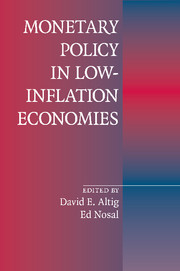Book contents
- Frontmatter
- Contents
- Contributors
- Acknowledgments
- Introduction
- 1 The Welfare Cost of Inflation in the Presence of Inside Money
- Commentary
- 2 An Open-Economy Model of Endogenous Price Flexibility
- Commentary
- 3 Efficient Inflation Targets for Distorted Dynamic Economies
- Commentary
- 4 Inflation and Welfare in Models with Trading Frictions
- Commentary
- 5 Good versus Bad Deflation: Lessons from the Gold Standard Era
- Commentary
- 6 Monetary Policy Orientation in Times of Low Inflation
- Commentary
- 7 Observations on Disinflation in Transition Economies
- Commentary
- 8 Inflation and Financial Market Performance: What Have We Learned in the Last Ten Years?
- Commentary
- Index
Introduction
Published online by Cambridge University Press: 26 January 2010
- Frontmatter
- Contents
- Contributors
- Acknowledgments
- Introduction
- 1 The Welfare Cost of Inflation in the Presence of Inside Money
- Commentary
- 2 An Open-Economy Model of Endogenous Price Flexibility
- Commentary
- 3 Efficient Inflation Targets for Distorted Dynamic Economies
- Commentary
- 4 Inflation and Welfare in Models with Trading Frictions
- Commentary
- 5 Good versus Bad Deflation: Lessons from the Gold Standard Era
- Commentary
- 6 Monetary Policy Orientation in Times of Low Inflation
- Commentary
- 7 Observations on Disinflation in Transition Economies
- Commentary
- 8 Inflation and Financial Market Performance: What Have We Learned in the Last Ten Years?
- Commentary
- Index
Summary
We live, we hope, in an era of low inflation. The global fiat-money standard in force today arguably began soon after World War II, notwithstanding the nominally gold-anchored Bretton Woods period. Using Alan Meltzer's (2005) proposed dating scheme, we might roughly divide history after the war into three subperiods: the post-Accord, the Great Inflation, and the Great Moderation episodes, covering, respectively, 1952–1964, 1965–1984, and 1984 onward. The annual rates of inflation in each of these subperiods, measured by the GDP deflator, averaged 1.8 percent in the first episode, 5.8 percent in the second, and 2.5 percent in the third.
If we exclude from the latter episode the 1985–1991 period—which in retrospect has the appearance of a transition phase—the episode's annual rate of inflation falls to 2.2 percent. Perhaps more importantly, the volatility of inflation fell dramatically relative to the Great Inflation period, to a level even lower than that realized over the post-Accord episode.
This inflation profile is, as most know, not unique to the United States. Summarizing research presented at a 2005 autumn meeting of central bank economists sponsored by the Bank of International Settlements, Will Melick and Gabriele Galati (2006) note that during the Great Moderation “the mean rate of inflation has often been judged to have fallen by the order of 10 percentage points” in industrialized countries, “while declines have been of the order of 20 to 30 percentage points for developing countries.” The observation about disinflation in developing countries is also the theme of Paul Wachtel and Iikka Korhonen's contribution to this volume.
- Type
- Chapter
- Information
- Monetary Policy in Low-Inflation Economies , pp. xiii - xxviPublisher: Cambridge University PressPrint publication year: 2009



